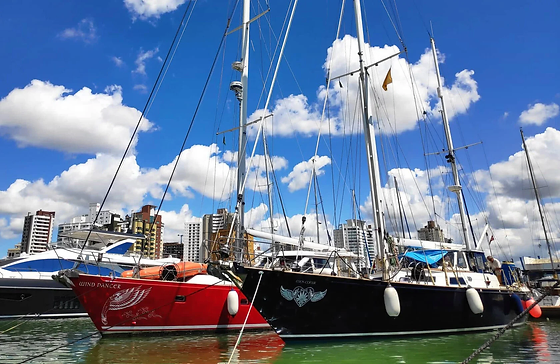
We manufacture UK Yacht for Sale. Classic wooden boats, sailing boats, and motor boats for sale. Check our website for more info about luxury yachts
It was blowing 20 to 25 knots out of the east-northeast, gusting to 30, as
more than 80 sailing yachts maneuvered off Nantucket last August for the
start of the annual Opera House Cup Race. There were many fast boats in the fleet, including a couple of former AMERICA’S Cup contenders, but the big race that day, the blood race, was between two giants that were tacking and jibing at opposite ends of the half-mile-long starting line.
Hugging the windward mark, the Nantucket Channel buoy was the ketch
WHITEHAWK, 92′ long, with a 20½’ beam, weighing in at 175,000 pounds and drawing 7’7″ with her 10′ daggerboard up. Cruising the leeward end of the line, to ensure sufficient water for the 13′ she
was drawing with her 3½’ racing keel extension attached, was the sloop
WHITEFIN, 90′ long, with a 21½ ‘ beam and weighing in at 135,000 pounds, 40,000 pounds lighter than her rival.
Although both boats carry approximately the same sail area—slightly more than 4,000 square feet—both were heavily reefed that blustery day. WHITEHAWK was under triple-reefed main and staysail only. WHITEFIN was flying a double-reefed main and a full-hoist blade jib.
Basic Sailing with a UK Yacht for Sale

The basic concept of sailing is quite simple, and sailing is something many people learn by themselves through trial and error. Young children are often the quickest to learn because they do not try to complicate matters. It will be easier to discuss what is involved, however, if we use some standard nautical terms and the specific names for the parts of the boat.
Refer to the ‘Short List of Nautical Terms’ at the back of the booklet and figures 1 and 2 for clarification. Don’t try to completely absorb all of
the material at once, but instead get some on-the-water experience. You can then come back to this material for a fuller understanding.
In its simplest form, to sail you do little more than point the boat where you want to go and pull in the sail enough to keep it from luffing
(i.e., keep it from shaking like a flag).
The Wind
It is not possible to sail straight into the wind, so if pulling in the sail does not stop the sail from luffing, the bow of the boat must be turned further away from the wind direction. When this is done the sail will automatically seek the leeward side of the boat (the side away from the wind). As you can see, it is important that you keep track of the wind at all times, particularly what your course is relative to the wind direction. Each change of the wind’s angle to the boat requires a sail adjustment.
Since the sailboat can not sail directly toward the wind, and because all our maneuvers should be thought of in relation to the wind direction, our first step is to determine the exact direction the wind is coming from. Wind direction can be determined in many ways; flags, smoke, and ripples on the water. But the most common method is by watching your telltale (pieces of yarn or other light material fastened to the wire stays).
The exact angle of the wind to your boat is something you must be aware of at all times if you are to intelligently and safely maneuver your boat. Every few moments you should be rechecking the wind’s relative angle to your boat. Although you may be using your telltales most of the time, it is also important to watch the water upwind so you will have advance warning of a change in the wind direction or strength. An added puff of wind will darken the surface of the water, and you will be able to watch the progress of the puff toward your boat. In this way you can be ready to take appropriate action.
